
By Walter Knitl – VP at AIoT Canada, CEO at Praxiem
Our world is undergoing massive digital transformation – literally.
It’s not just due to the ever-increasing speed and impact of data created and exchanged among humans (through our clicks, scrolls, and swipes) and the AI-empowered digital entities and applications in cyberspace.
It’s also because our physical world is rapidly digitalizing, where literal physical things and spaces around us are endowed with digital personas, casting them into cyberspace to co-mingle with the humans and digital applications already there. That, in a nutshell, is the Internet of Things (IoT), made possible by exponential advancements in embedded computing, communications, and physical sensing and actuating technologies. And that is undeniably the result of exponential semiconductor cost, power, scale, and performance advancements.
The IoT Space
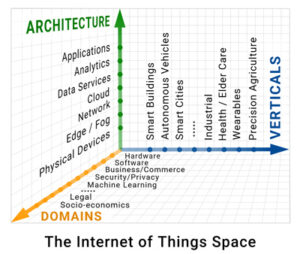
Although IoT is, architecturally, an extension of the internet that now touches the physical world, it inevitably ties in other dimensions that create the IoT space.
The architecture dimension envelopes the bits and pieces that construct IoT – the devices, networks, cloud and edge computing, data management, and data services.
But, like a hammer, an IoT architecture is only a means to an end and not the end itself. The real value of IoT is in the verticals dimension where the IoT architecture is applied to solutions in the various verticals – resulting from the insights gained from physical-world data. The following are just some verticals that derive significant value from IoT.
- Industry and Advanced Manufacturing
- Transportation and Mobility
- Logistics
- Health
- Precision Agriculture
- Wearables
- Smart Cities
- and more
Across the verticals, in aggregate, IoT raises productivity, elevates quality of life, supports sustainability, and is a critical factor in international competitiveness.
While the architecture and verticals dimensions comprise the means and values of IoT, they are enabled by innovations in many domains and disciplines and drive back impact and transformation in various domains. That disciplines and domains dimension includes not only technological domains such as new software and hardware and disciplines like cybersecurity, but also new business models and paradigms, as well as socioeconomic and governance imperatives.
To fully navigate and reap the benefits of IoT, we must look at it holistically as a space with several dimensions instead of just a single-dimensional collection of architectural bits and pieces.
Enter – AI and AIoT
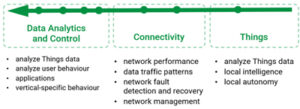
So, how do we derive value from IoT?
Clearly, the value of IoT comes from the insights derived from the massive physical-world data it generates, enabling better business and societal decisions and effective control of physical things and spaces around us. And, given the great data volume and velocity, machine learning and AI step in to provide the timely and massive analytics and reactions not possible by humans, nor increasingly through legacy programmatic computing.
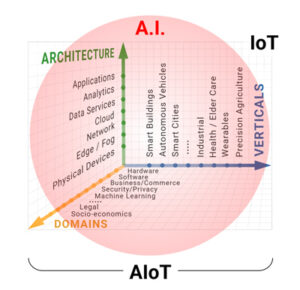
As a result, it’s tempting to think of AI applications in the IoT space as just the analytics piece in the architecture dimension, whether in the cloud or the edge.
Not so!
AI has infiltrated the whole IoT space – in all dimensions – not just the IoT data analytics. For example, consider just the architecture dimension, summarized at a high level, consisting of Things, Connectivity, Analytics and Control.
Yes, there are AI-based device data analytics at the edge and in the cloud. However, AI also plays a crucial role in monitoring and ensuring network and connectivity robustness and resilience, whether wired or wireless, such as 5G. AI also plays a critical role in data management, whether in the cloud or the edge. AI is increasingly deployed within Things such as drones, cars, and machinery, making them intelligent and autonomous.
The bottom line is that IoT and AI are tied at the hip. AI is inextricable from the IoT space, whether creating value from physical world data, enabling IoT architecture construction, or gluing IoT solutions together in different verticals. The result is the holistic combination of AI + IoT, or AIoT.
AIoT Ecosystem and AIoT Canada
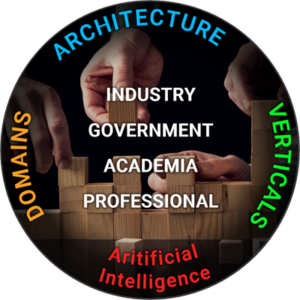
AIoT is poised to be a massive driver of economic growth and competitiveness. But how do we release and leverage that growth potential for Canada’s economy?
In business, as in nature, things don’t just grow better in ecosystems – they thrive. And so it is for AIoT-based economic growth. But – there are ecosystems, and then there are ecosystems. It’s an overloaded term finding widespread use with varied meanings in different contexts. Nevertheless, the common thread is a community of mutually dependent members that dwell in or deliver different aspects or parts of a common sphere of endeavour and derive mutual benefit. In the case of an AIoT ecosystem, its membership should involve the IoT space’s different aspects or dimensions (architecture, verticals, domains) and the related AI. The derived benefits include mutual catalyzation and access to talent and innovation, investment attraction, and business growth. The ecosystem’s members or actors should comprise a diverse cross-section of organizations, including industry, government, academia, and professionals.
And that – is the mission of AIoT Canada.
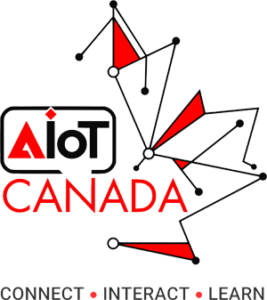
AIoT Canada is a non-profit organization focused on building an inclusive AIoT ecosystem of industry, academic, and government members, which can leverage the power of AIoT for its members and help grow Canada’s economic competitiveness and influence. Members range from large established industry players to new technology innovators and providers, seasoned and early adopters, service providers, and research and academia.
AIoT Canada’s mission is fulfilled by providing a forum for members to connect, interact, and learn from each other through events, newsletters, webinars, and advisory opportunities. Members are encouraged to collaborate or form partnerships to innovate or adopt AIoT.
The organization also advocates using AIoT by industry (at large) and creating government policies to advance AIoT innovation and adoption and mitigate some of its risks.
Two significant initiatives form the core of AIoT Canada’s strategic work.
- Industry Mapping
- National Strategy Council (NSC)
The Industry Mapping initiative aims to map the Canadian AIoT ecosystem, including all AIoT providers, adopters, and other stakeholders – i.e., who’s doing what in what sectors?
The National Strategy Council (NSC) is a group of AIoT stakeholders guiding the development of a Canadian AIoT strategy. The objective of the national strategy is to identify opportunities for Canada to grow its productivity and economy through AIoT, the challenges faced in reaching for the opportunities, and specific solution recommendations for addressing the opportunities and challenges. The need for a national strategy and the NSC culminated from a national strategy roundtable held in Kanata (Ottawa) involving industry, academic, and some government participants, confirming AIoT Canada’s original tenets.
AIoT Summit
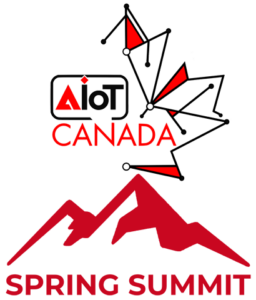 As the NSC began working on the national strategy, the critical need to feed the strategy with ongoing stakeholder dialogue became apparent – not just with AIoT Canada’s membership but also with the broader industry, academia, and government. And, tightly coupled with that, it was imperative to spread the word about AIoT’s merits for Canada’s economy to garner the breadth and diversity of that dialogue.
As the NSC began working on the national strategy, the critical need to feed the strategy with ongoing stakeholder dialogue became apparent – not just with AIoT Canada’s membership but also with the broader industry, academia, and government. And, tightly coupled with that, it was imperative to spread the word about AIoT’s merits for Canada’s economy to garner the breadth and diversity of that dialogue.
As a result, AIoT Canada has reached out directly to individual AIoT stakeholders and collaborated with organizations such as past IoT North Conferences and Tech Tuesday in Ottawa for broader conversations around AIoT economic opportunities and challenges.
That NSC experience uncovered AIoT Canada’s imperative to convene a national summit on AIoT as its pillar of conversation around AIoT’s merits and strategy toward Canada’s economic growth.
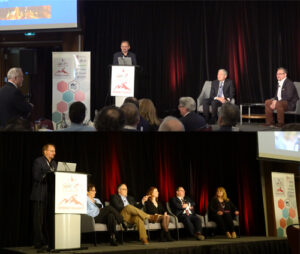
That culminated in the first AIoT Canada Spring Summit on April 10, 2024, fortuitously (albeit unexpectedly) aligned with Canada’s Government’s announcement of significant investment in Artificial Intelligence innovation. Needless to say, the government’s foresight into AI’s broader critical role in Canada’s future is synergetic with AIoT Canada’s imperative for AI’s crucial role in creating value from IoT and the digitalization of physical things and spaces.
The Spring Summit brought together over 150 industry, government, and academic participants to hear speakers on AIoT’s impacts and implications in several verticals and disciplines. That included talks about AIoT in transportation, sustainability, and manufacturing from Amy Karam, Jean-Simon Venne, and Valérie Judd-Rohal, respectively. The summit also included insights into the legal implications of AIoT from Edona Vila and an overview of the Government of Canada’s digital transformation and AI evolution from Shared Services President Scott Jones.
The Summit’s highlight was a fireside chat with The Honourable François-Philippe Champagne, Canada’s Minister of Innovation Science and Economic Development (ISED). That was a timely discussion coming on the heels of ISED’s AI announcement, which was profoundly synergistic with AIoT Canada’s mission.
There were numerous valuable takeaways from the Spring Summit, to be summarized in a separate article. Still, Terry Matthews of Wesley Clover International profoundly summarized the overarching takeaway in his host address:
“The time for AIoT is now!“

Beyond the summit
So – what comes after the summit? Another summit to climb!
And the path to it is strewn with opportunities to pick up and hills to conquer.
The key opportunities and imperatives include strengthening AIoT stakeholders’ dialogue. AIoT Canada is eager to hear from everyone about their visions and needs to leverage AIoT for their business and realize its forte for Canada’s economy. Visit the AIoT Canada website to subscribe, get info, or provide input. If you’d like to engage specifically about the national strategy, visit the NSC webpage. And – become a member to have deeper involvement and influence in Canada’s AIoT ecosystem.
Additionally, it’s imperative for the public sector to elevate its digital literacy around physical digitalization, the foundation of IoT and AIoT, to inform its AIoT-based economic development and digital risk mitigation policies.
And – since AIoT does not stand alone and overlaps critical technologies such as 5G and semiconductors, Canada should consider how to support Canadian companies in integrating and testing these technologies (5G, Semiconductors, IoT, AI, etc.). Establishing an open test and integration centre (OTIC) would enable companies to integrate and validate their products and innovations, helping Canada become a world leader in AIoT.
Let’s climb to the next summit together.

